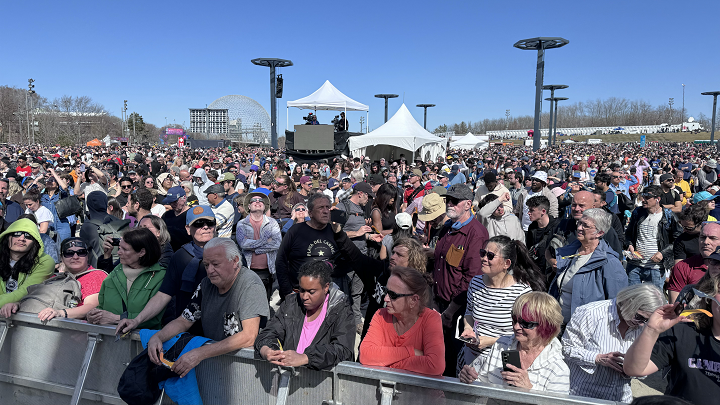A once-in-a-lifetime solar eclipse passed through portions of Eastern Canada on Monday, with several cities hosting an influx of sightseers who were eager to stand in utter darkness across the path of totality on April 8.

While estimates are not yet available, crowds did not appear as enormous as first anticipated and there were no major traffic incidents as of 4:30 p.m. EDT.
Still, the spectacle drew in people from far and wide and many attendees described feeling emotionally and spiritually moved by the celestial event.

What time was the eclipse?
The eclipse first hit Ontario from the south just before 2 p.m. EDT on Monday and departed Newfoundland just after 5 p.m. EDT, or 6:30 p.m. NDT.
Hot spots like Niagara Falls and Kingston, Ont., Montreal, and Fredericton, N.B., received maximum coverage, with some experiencing it for as long as three and half minutes as the moon passed between the sun and Earth.
Here’s more on what happened at some of the most popular spots hosting viewing events.
Fort Erie
Maximum totality (maximum coverage of the sun): 3 mins. 43 secs. between 3:18 p.m. and 3:21 p.m. EDT
The last time the Fort Erie area saw a solar eclipse was in 1925 and another one won’t be back until 2144.
Although the skies didn’t clear entirely on Monday, most who travelled out to nearby beaches and the Peace Bridge weren’t disappointed.
The municipality experienced the longest duration of darkness in Ontario, due to being closest to the centre of the path of totality.
Of the hundreds gathered on Waverly Beach to experience almost four minutes of darkness, most said it was time well spent.
“You know, I’ve been through a few partials and it was still exhilarating,” said James Ballard, who travelled some 326 kilometres from Sarnia, Ont.
“I drove almost four hours to get here and I don’t think it was a waste of time.”
Local Ben Madsen, who savoured the three minutes and 46 seconds of dark skies, said it was simply “awesome.”
“This is probably the most supernatural event I’ve ever seen in my life. It was pretty incredible,” Madsen said.
Hamilton
Maximum totality (maximum coverage of the sun): 1 min. 47 secs. between 3:18 p.m. and 3:20 p.m. EDT
Hamilton was lucky enough to get a break in the clouds Monday afternoon, allowing several thousand to experience a couple of minutes of total darkness at Tim Hortons Field.
Overcast skies threatened to ruin the celestial event for much of the day, but blue skies emerged in the west over the Mountain just in time. The crowd cheered as the temperature dropped rapidly and darkness descended on the stadium during totality.
Several visitors from the Toronto area opted to travel down the QEW to get a total eclipse experience, including Mason Adams from Uxbridge, who was celebrating her 21st birthday.
“It was beautiful,” a beaming Adams said.
“I’m so glad we made the choice to come. It was cleared up right in time. We got a really good view.”
Another total eclipse will not be seen in Hamilton for another 120 years.
Niagara Falls
Maximum totality (maximum coverage of the sun): 3 mins. 32 secs. between 3:18 p.m. and 3:21 p.m. EDT

The eclipse began its partial phase in Niagara Falls, Ont., at 2:04 p.m. Monday and hit totality at 3:18 p.m., lasting about three and a half minutes.
In January, National Geographic tagged the spot as the “most picturesque” place to view the eclipse with ideal vantage points and the “iconic waterfalls thundering in the background.”
With the city being a reasonable distance from half the population of North America, the spot was an attractive location that had the potential to draw in hundreds of thousands of visitors. However, clouds did not clear out in time for peak viewing.
Still, Global News senior correspondent Jeff Semple said the clouds shifted briefly at the moment of the total eclipse.
“The crowd where we were started screaming,” he recounted.
Several attendees, some travelling from as far as Colombia, told Global News’ Caryn Lieberman that they were not disappointed by the clouds and that the experience was emotionally and spiritually moving.
The last time Niagara Falls saw a solar eclipse was in 1925 and another one won’t be back until 2144.
Kingston
Maximum totality (maximum coverage of the sun): 2 mins. 52 secs. between 3:22 p.m. and 3:23 p.m. EDT

Crowds gathered near the waterfront and around city hall in Kingston, Ont., could be heard cheering throughout the downtown as totality hit right on schedule at 3:22 p.m.
The cheers were followed by an eerie quiet at Confederation Park as the hundreds of people gathered to watch the glowing ring in the sky and took in the sudden nighttime conditions caused by the eclipse.
And then, just like that, the sun reappeared and the crowds cheered again.
Kingston seems to have avoided what city officials worried would be the “worst-case scenario” – hundreds of thousands of people clogging city streets following the eclipse.
Leading up to the eclipse the city had said anywhere between 70,000 and 500,000 visitors were expected to visit Kingston for the eclipse, depending on weather conditions.
Whether it was cloudy conditions that kept the big crowds away, the preparation of city officials who strategically planned viewing events across the city or a combination of both, the city appears to have avoided the worst of the gridlocked traffic officials had feared.
A city spokesperson told Global News an estimate of how many people actually visited Kingston would be made available on Tuesday.
Montreal
Maximum totality (maximum coverage of the sun): 1 min. 26 secs. between 3:26 p.m. and 3:27 p.m. EDT

In Montreal, the show did not disappoint. Thousands flocked to Parc Jean-Drapeau, with some early birds arriving at 7 a.m. Monday. Organizers confirmed around 100,000 people took part in the festivities on the island.
Before the eclipse even began, the crowd was so big, it was being compared to what one might expect at a Taylor Swift concert.
The turnout was so imposing that authorities were forced to close off both ramps leading to the park from the Jacques Cartier Bridge just before 2:30 p.m.
The mood leading into the 90-second show was electric and when darkness fell cheering could be heard ringing out in various parts of the city where impromptu viewing parties were held.
According to the city, the last total eclipse in Montreal happened in 1932.
Tourists chasing the eclipse also converged on the Eastern Townships region of the province, with totality in some areas lasting up to three and a half minutes. Some, like Cathy Slaun White and Chris Robart, both in their 60s, went to great lengths for a chance at the best view.
After looking at the forecast on Sunday, they hopped into their car and drove all the way from Kingston, Ont., despite hotels in the Townships being fully booked.
“We stayed at the hotel Walmart parking lot,” Robart said, adding that sleeping in the car was “worth it.”
The local tourist town of North Hatley saw an influx of visitors usually only seen in the height of summer. One family flew in from Los Angeles via Dallas, while another family travelled 40 hours from Australia to reunite with relatives for the unique event.
Other Quebec municipalities in the path of totality included Sherbrooke, Lac-Mégantic and Cap-aux-Meules, with the total solar eclipse taking place between 3:25 and 3:40 pm. depending on the region.
Fredericton
Maximum totality (maximum coverage of the sun): 2 min. 12 secs. between 4:33 p.m. and 4:35 p.m. ADT

The first sighting in Fredericton, N.B., started with a partial phase emerging at 3:23 p.m. local time on Monday and the path of totality began at 4:33 p.m., lasting just over two minutes.
Other areas that experienced 100 per cent totality include Woodstock, Florenceville-Bristol and Miramichi. Each of those venues saw the sun’s light covered by the moon for just over three minutes.
In Miramichi, a large crowd had amassed at the local airport by midday. As many as 15,000 were expected in total, with clear skies creating the ideal viewing conditions. A final crowd estimate is not yet available.
Among those gathered was Gregory MacIvor, 56, who was born and raised in Miramichi but now resides in Calgary.
He’s been waiting since he first learned about the eclipse when he was 11 years old.
“I was worried. 2024? I might be working on a moon base by then. I might not get a chance to see it,” he recalled.

P.E.I. and Newfoundland
Maximum totality (maximum coverage of the sun): 3 min. 15 secs. between 4:35 p.m. and 4:38 p.m. ADT in northern P.E.I.; 2 min. 54 secs. between 5:15 p.m. and 5:16 p.m. NDT in eastern Newfoundland
The path of totality also included the northern half of Prince Edward Island, a sliver of the northern tip of Nova Scotia and throughout central Newfoundland.
In fact, Newfoundland was the destination of the final viewing of the eclipse in North America.
— with files from Global News’ Don Mitchell, Shane Gibson, Annabelle Olivier, Kalina Laframboise and Rebecca Lau.










Comments